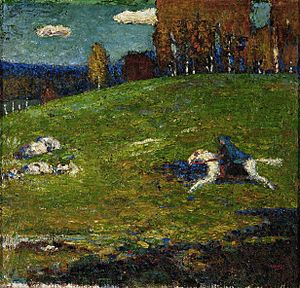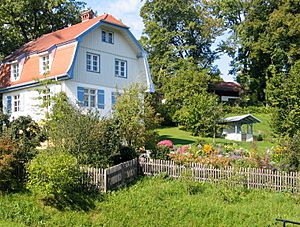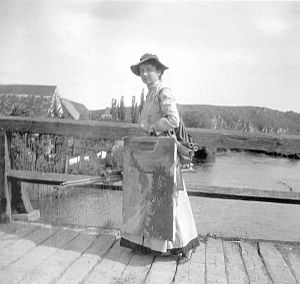Gabriele Münter facts for kids
Quick facts for kids
Gabriele Münter
|
|
|---|---|
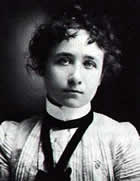
Gabriele Münter in 1900
|
|
| Born | 19 February 1877 |
| Died | 19 May 1962 (aged 85) Murnau am Staffelsee, Bavaria, West Germany
|
| Known for | Painting |
| Movement | Expressionism |
Gabriele Münter (born February 19, 1877 – died May 19, 1962) was a German Expressionist painter. She was a leading artist in the Munich art scene in the early 1900s. She studied art and lived with the famous painter Wassily Kandinsky. Gabriele Münter was also one of the artists who started the Expressionist art group called Der Blaue Reiter (The Blue Rider).
Her Early Life and Art Training
Gabriele Münter was born in Berlin on February 19, 1877. Her family was well-off and supported her dream of becoming an artist. She started drawing when she was a child. Her father passed away in 1886.
When she was 20, Münter began her art training. She studied in Düsseldorf with Ernst Bosch and later with Willy Spatz. By age 21, both her parents had died. She inherited a lot of money, which allowed her to live freely. In 1898, she traveled to America with her sister. They stayed for over two years, mostly in Texas, Arkansas, and Missouri. She filled six sketchbooks with drawings of people, plants, and landscapes from her trip. This free and independent life helped shape her future as an artist. She learned different art techniques like woodcut, sculpture, painting, and printmaking.
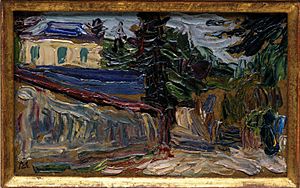
In 1901, Münter joined classes at the Women's Academy in Munich. She then studied at the Phalanx School in Munich. This was a modern art school started by the Russian artist, Wassily Kandinsky. Women were not allowed in official art academies in Munich and Düsseldorf. So, the Phalanx School was a great chance for her. At this school, Münter learned about Post-Impressionism. She also learned how to use a palette knife and brush in new ways.
Her bright colors and strong outlines were inspired by artists like Paul Gauguin and the Fauves. She also loved Bavarian folk art, especially a technique called reverse-glass painting.
Soon after starting classes, Münter and Kandinsky began working together. Their professional relationship turned into a personal one that lasted more than ten years. Kandinsky was the first teacher who truly believed in Münter's painting skills. In the summer of 1902, Kandinsky invited her to his summer painting classes. These classes were held in the Alps, south of Munich.
At first I had a lot of trouble with my brushwork. Kandinsky taught me how to get the effects I wanted with a palette knife... My main problem was I couldn't paint fast enough. My pictures are like moments of life. They are quick, sudden visual experiences. When I start to paint, it's like jumping into deep water. I never know if I'll be able to swim. Well, Kandinsky taught me how to swim. He taught me to work fast enough and with enough confidence. This helped me capture these quick and spontaneous moments of life.
—Gabriele Münter, Reinhold Heller, Gabriele Münter: The Years of Expressionism 1903–1920. New York: Presteverlag, 1997.
Her Artworks
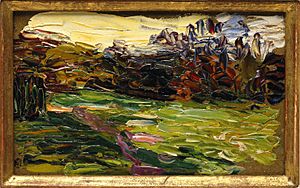
Münter focused a lot on German Expressionism. She used many different art forms. She made many woodcuts and linocuts. She also kept a journal and took photos with a modern camera. She knew many famous artists of her time. In her journals, she wrote that she wanted to learn from the modern artists in France.
Münter was part of a small group of artists. They changed art from Impressionism and Art Nouveau into Expressionism. Early on, Münter loved painting landscapes. Her landscape paintings were simple and symbolic, like Art Nouveau. They used soft colors, flat shapes, and less depth. She also enjoyed painting children. She made colorful prints of children and toys. These works showed her precise and simple style.
Around 1908, her art began to change. She was greatly influenced by artists like Matisse, Paul Gauguin, and Vincent van Gogh. Her work became more realistic. She found peace in Murnau, a small Bavarian town. This village was untouched by factories and modern changes. Münter bought a house in Murnau. She spent much of her life there. In her Murnau landscape paintings, she focused on nature. She created imaginative scenes that were different from German modern art.
Münter's landscapes are special because she used blues, greens, yellows, and pinks. Color was very important in her early works. She used colors to show feelings. Her paintings were often picturesque, inviting, and full of fantasy. In her landscapes, she showed the village and countryside as part of human life. Nature and people always interacted in her art.
Münter and Kandinsky's relationship also changed Kandinsky's art. He started using Münter's bright colors and abstract style. They traveled through Europe, visiting the Netherlands, Italy, and France. They also went to North Africa. During this time, they met artists like Henri Rousseau and Henri Matisse. Münter and Kandinsky helped start an art group in Munich. It was called the New Artists’ Association (Neue Künstlervereinigung). She showed her art in many important modern art exhibitions in Germany before World War I.
In 1911, Münter was one of the first artists to show her work with Kandinsky's group. This group was called Der Blaue Reiter (The Blue Rider). The artists in this group had different styles and goals. But they all wanted to show spiritual truths through their art. They supported modern art. They also believed in connecting art with music. They saw spiritual meanings in colors. They liked to paint in a spontaneous and intuitive way. This helped them move towards abstract art.
Münter's art changed from simply copying nature to feeling its deeper meaning. She started to abstract things and show their essence. She became interested in painting the spirit of modern life. She showed its social changes and how people felt disconnected. Münter said her pictures were like moments of life. They were quick, sudden visual experiences. Each of her paintings had its own identity, shape, and purpose.
For Münter, color was key to showing these ideas. German Expressionists looked to primitive art for inspiration. They wanted art that was not academic or traditional. They searched for the hidden mystery behind what things looked like. They wanted to show the true soul of things.
Later Years
When World War I started, Münter and Kandinsky moved to Switzerland. In 1914, Kandinsky went back to Russia without her. In 1917, he married Nina Andreevskaya. This ended Münter and Kandinsky's relationship. After this, Münter did not paint much for a while. She returned some paintings and drawings to Kandinsky. She stored other artworks in a warehouse for many years. She started painting again in the late 1920s. This was after she moved back to Germany with Johannes Eichner.
In the 1930s, Europe faced rising tensions. The Nazi government in Germany did not like modern art. So, Münter moved all the artworks by her, Kandinsky, and other Blue Rider members to her house. She hid them there. Even though she had money problems, she carefully protected them during World War II. Her house was searched several times, but the artworks were never found.
On her 80th birthday, Münter gave her entire art collection to the Städtische Galerie in the Lenbachhaus museum in Munich. This collection included over 80 oil paintings and 330 drawings. In 1956, Münter received awards, like the Culture Prize from the City of Munich. Her work was shown in the US for the first time in the 1960s. It was also shown at the Mannheim Kunsthalle in 1961. She continued to represent the Expressionist movement while she was with Johannes Eichner.
The Gabriele Münter and Johannes Eichner foundation was created. It is now an important place to study Münter's art. It also studies the art made by the Blue Rider group. Münter lived the rest of her life in Murnau. She traveled back and forth to Munich. She passed away at her home in Murnau am Staffelsee on May 19, 1962.
In 2018, the Louisiana Museum of Modern Art in Copenhagen, Denmark, held an exhibition. It showed about 130 works by Gabriele Münter. Many of these had never been shown before. It was her first big art show in many years.
Her Art Style
Münter's art style changed over her career. Her early works from the Phalanx school used a lot of palette knife work. They had a limited range of colors like yellows, greens, and browns. Her later landscapes, many painted in Murnau, used strong outlines. They featured colors like blue, green, yellow, and pink, often with red highlights. Color always played a big part in her art. In the early 1920s, Münter painted portraits. These portraits had simple lines and clear compositions. This style was popular in the Neue Sachlichkeit (New Objectivity) art movement of that time.
See also
 In Spanish: Gabriele Münter para niños
In Spanish: Gabriele Münter para niños
- List of German women artists


